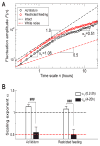Fractal Regulation in Temporal Activity Fluctuations: A Biomarker for Circadian Control and Beyond
- PMID: 28553673
- PMCID: PMC5443249
Fractal Regulation in Temporal Activity Fluctuations: A Biomarker for Circadian Control and Beyond
Abstract
Motor activity in humans and other animals possesses fractal temporal fluctuations that co-exists with circadian or daily activity rhythms. The perturbations in fractal activity patterns are often accompanied by altered circadian/daily rhythms. The goal of this study is to test whether fractal regulation in motor activity provides physiological information independent from 24-h/circadian rhythmicity. To achieve the goal, we studied locomotor activity recordings of rats with the lesion of the suprachiasmatic nucleus (SCN) that are known to have diminished circadian/daily activity rhythms and perturbed fractal regulation. By restricting feeding time (i.e., food was only availability in the dark period of the 12h: 12h light-dark cycles), we found that mean activity levels in these animals displayed significant 24-h rhythms. In contrast, the restricted feeding had no influences on the perturbed fractal regulation in these SCN-lesioned animals, i.e., activity fluctuations in these animals remained random over a wide range of time scales from 2-20h. Our results indicate that 24-h rhythm of food availability can restore/improve circadian/daily rhythms in the SCN-lesioned animals but not necessarily improve the disrupted fractal activity regulation in these animals. This study provides clear and direct evidence that fractal activity patterns offer complementary information about motor activity regulation at multiple time scales that is beyond 24-h rhythm control.
Keywords: Circadian rhythm; Food restriction; Fractal activity regulation; Inter-daily stability (IS); Motor activity.
Figures




Similar articles
-
Interactive Effects of Dorsomedial Hypothalamic Nucleus and Time-Restricted Feeding on Fractal Motor Activity Regulation.Front Physiol. 2016 May 18;7:174. doi: 10.3389/fphys.2016.00174. eCollection 2016. Front Physiol. 2016. PMID: 27242548 Free PMC article.
-
Simulated shift work in rats perturbs multiscale regulation of locomotor activity.J R Soc Interface. 2014 Jul 6;11(96):20140318. doi: 10.1098/rsif.2014.0318. J R Soc Interface. 2014. PMID: 24829282 Free PMC article.
-
Effects of suprachiasmatic transplants on circadian rhythms of neuroendocrine function in golden hamsters.Endocrinology. 1999 Jan;140(1):207-18. doi: 10.1210/endo.140.1.6428. Endocrinology. 1999. PMID: 9886827
-
Circadian neural rhythms in mammals.Annu Rev Physiol. 1985;47:49-64. doi: 10.1146/annurev.ph.47.030185.000405. Annu Rev Physiol. 1985. PMID: 2859834 Review.
-
The role of the circadian system in fractal neurophysiological control.Biol Rev Camb Philos Soc. 2013 Nov;88(4):873-94. doi: 10.1111/brv.12032. Epub 2013 Apr 10. Biol Rev Camb Philos Soc. 2013. PMID: 23573942 Free PMC article. Review.
Cited by
-
Fractal motor activity regulation and sex differences in preclinical Alzheimer's disease pathology.Alzheimers Dement (Amst). 2021 Jun 23;13(1):e12211. doi: 10.1002/dad2.12211. eCollection 2021. Alzheimers Dement (Amst). 2021. PMID: 34189248 Free PMC article.
-
Reduced Tolerance to Night Shift in Chronic Shift Workers: Insight From Fractal Regulation.Sleep. 2017 Jul 1;40(7):zsx092. doi: 10.1093/sleep/zsx092. Sleep. 2017. PMID: 28838129 Free PMC article.
-
Dietary restriction modulates ultradian rhythms and autocorrelation properties in mice behavior.Commun Biol. 2024 Mar 9;7(1):303. doi: 10.1038/s42003-024-05991-3. Commun Biol. 2024. PMID: 38461321 Free PMC article.
-
A dynamically coherent pattern of rhythms that matches between distant species across the evolutionary scale.Sci Rep. 2023 Apr 1;13(1):5326. doi: 10.1038/s41598-023-32286-0. Sci Rep. 2023. PMID: 37005423 Free PMC article.
-
Disturbances in rest-activity rhythms and their neurobiological correlates: implications for Alzheimer's disease and dementia.Sleep. 2025 May 12;48(5):zsaf047. doi: 10.1093/sleep/zsaf047. Sleep. 2025. PMID: 40045738 Free PMC article. No abstract available.
References
-
- Cole BJ. Fractal time in animal behaviour: the movement activity of Drosophila. Animal Behaviour. 1995;50:1317–1324.
Grants and funding
LinkOut - more resources
Full Text Sources
